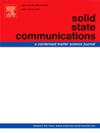Ca2+取代对BaTi0.95Sn0.05O3介电和铁电行为的影响:电子密度分布的研究
IF 2.4
4区 物理与天体物理
Q3 PHYSICS, CONDENSED MATTER
引用次数: 0
摘要
本研究采用常规固相烧结法制备无铅ba1 - xcaxti0.95 sn0.050 o3 (x = 0.0, 0.05, 0.10, 0.15, 0.20)陶瓷。研究了Ca2+在a位掺杂对结构、介电、铁电和电应变性能的影响。XRD、Rietveld细化和Raman光谱结果表明,在0.0≤x≤0.10的组成范围内,正交(O)相和四方(T)相共存。通过精细结构因子的电荷密度分析,确定了Ti和O原子之间的共价键。随着Ca2+含量的增加,居里温度(TC)从71.1℃升高到91.5℃。电学性能在x = 0.05时最佳,Pm为⁓16.56 μC/cm2, Pr为⁓10.78 μC/cm2, EC为⁓3.02 kV/cm, Smax = 0.096%, d33 * = 355 Pm /V。该组合物表现出改善的铁电和电应变性能,x范围在0.0到0.05之间,使其成为无铅压电陶瓷的有希望的候选材料。本文章由计算机程序翻译,如有差异,请以英文原文为准。
Impact of Ca2+ substitution on the dielectric and ferroelectric behavior of BaTi0.95Sn0.05O3: A study of electron density distribution
In this study, lead-free Ba1-xCaxTi0.95Sn0.05O3 (x = 0.0, 0.05, 0.10, 0.15, and 0.20) ceramics were prepared using the conventional solid-state sintering route. The effects of Ca2+ doping at the A-site on the structural, dielectric, ferroelectric, and electrostrain properties were investigated. XRD, Rietveld refinement, and Raman spectra results revealed the coexistence of orthorhombic (O) and tetragonal (T) phases within the composition range of 0.0 ≤ x ≤ 0.10. The covalent bond between Ti and O atoms was confirmed through charge density analysis using refined structure factors. The Curie temperature (TC) showed an increasing trend from 71.1 °C to 91.5 °C with the addition of Ca2+ content. The best electrical properties were observed at x = 0.05, with values of Pm ⁓ 16.56 μC/cm2, Pr ⁓ 10.78 μC/cm2, EC ⁓ 3.02 kV/cm, Smax = 0.096 %, and d33∗ = 355 p.m./V. The compositions exhibited improved ferroelectric and electrostrain properties for x ranging from 0.0 to 0.05, making them promising candidates for lead-free piezoelectric ceramics.
求助全文
通过发布文献求助,成功后即可免费获取论文全文。
去求助
来源期刊

Solid State Communications
物理-物理:凝聚态物理
CiteScore
3.40
自引率
4.80%
发文量
287
审稿时长
51 days
期刊介绍:
Solid State Communications is an international medium for the publication of short communications and original research articles on significant developments in condensed matter science, giving scientists immediate access to important, recently completed work. The journal publishes original experimental and theoretical research on the physical and chemical properties of solids and other condensed systems and also on their preparation. The submission of manuscripts reporting research on the basic physics of materials science and devices, as well as of state-of-the-art microstructures and nanostructures, is encouraged.
A coherent quantitative treatment emphasizing new physics is expected rather than a simple accumulation of experimental data. Consistent with these aims, the short communications should be kept concise and short, usually not longer than six printed pages. The number of figures and tables should also be kept to a minimum. Solid State Communications now also welcomes original research articles without length restrictions.
The Fast-Track section of Solid State Communications is the venue for very rapid publication of short communications on significant developments in condensed matter science. The goal is to offer the broad condensed matter community quick and immediate access to publish recently completed papers in research areas that are rapidly evolving and in which there are developments with great potential impact.
 求助内容:
求助内容: 应助结果提醒方式:
应助结果提醒方式:


